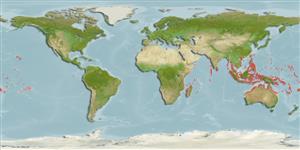>
Ovalentaria/misc (Various families in series Ovalentaria) >
Pomacentridae (Damselfishes) > Glyphisodontinae
Etymology: Abudefduf: Arabic, abu = father; this fish is the leader of the reef against other species (Ref. 45335).
More on author: Cuvier.
Environment: milieu / climate zone / profondeur / distribution range
Écologie
marin récifal; non migrateur; profondeur 0 - 20 m (Ref. 4391). Tropical; 25°N - 35°S, 35°E - 143°W
Indo-Pacific: East Africa to the Line and Tuamoto islands, north to southern Japan, south to southern Great Barrier Reef.
Taille / Poids / Âge
Maturité: Lm ? range ? - ? cm
Max length : 23.0 cm TL mâle / non sexé; (Ref. 4391)
Description synthétique
Clés d'identification | Morphologie | Morphométrie
Épines dorsales (Total) : 13; Rayons mous dorsaux (Total) : 12 - 14; Épines anales: 2; Rayons mous anaux: 11 - 13.
Body shape (shape guide): short and / or deep; Cross section: compressed.
Adults inhabit lagoon and outer reefs in shallow areas exposed to mild or moderate surge. Feed on benthic algae and small invertebrates (Ref. 7247). Oviparous, distinct pairing during breeding (Ref. 205). Eggs are demersal and adhere to the substrate (Ref. 205). Males guard and aerate the eggs (Ref. 205). Highly territorial (Ref. 9710). Maximum depth reported taken from Ref. 128797.
Life cycle and mating behavior
Maturité | Reproduction | Frai | Œufs | Fécondité | Larves
Oviparous, distinct pairing during breeding (Ref. 205). Eggs are demersal and adhere to the substrate (Ref. 205). Males guard and aerate the eggs (Ref. 205).
Allen, G.R., 1991. Damselfishes of the world. Mergus Publishers, Melle, Germany. 271 p. (Ref. 7247)
Statut dans la liste rouge de l'IUCN (Ref. 130435: Version 2025-1)
Menace pour l'homme
Harmless
Utilisations par l'homme
Pêcheries: intérêt commercial mineur
Outils
Articles particuliers
Télécharger en XML
Sources Internet
Estimates based on models
Preferred temperature (Réf.
123201): 25.6 - 29.3, mean 28.6 °C (based on 2458 cells).
Phylogenetic diversity index (Réf.
82804): PD
50 = 0.5000 [Uniqueness, from 0.5 = low to 2.0 = high].
Bayesian length-weight: a=0.02239 (0.00954 - 0.05253), b=3.08 (2.89 - 3.27), in cm total length, based on LWR estimates for this Genus-body shape (Ref.
93245).
Niveau trophique (Réf.
69278): 3.0 ±0.38 se; based on food items.
Résilience (Réf.
120179): Milieu, temps minimum de doublement de population : 1,4 à 4,4 années (Preliminary K or Fecundity.).
Fishing Vulnerability (Ref.
59153): Low vulnerability (13 of 100).
🛈
Nutrients (Ref.
124155): Calcium = 73.8 [38.0, 120.9] mg/100g; Iron = 0.625 [0.355, 1.025] mg/100g; Protein = 18.6 [17.3, 19.7] %; Omega3 = 0.0831 [, ] g/100g; Selenium = 16.9 [9.0, 33.3] μg/100g; VitaminA = 75 [21, 251] μg/100g; Zinc = 1.43 [0.95, 2.13] mg/100g (wet weight);
